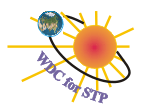|
|
|
Muon Telescope Data
To register the muon component, muon telescopes are used. The number of muon telescopes operating in the world is much smaller than the number of neutron monitors, although muon observations
began many years before the creation of neutron monitors. Thus, muon data for a larger number of solar cycles are available for studying solar modulation on anisotropy and other cosmic ray variations.
Observations of surface muons have significant responses
from about 10 GeV to several hundred GeV, underground muon observations extend to a little over 1000 GeV. At the minimum of the muon observation range, the dominant modulation processes are similar
to those observed on neutron monitors. With increasing energy, galactic effects become more common, and solar modulation disappears.
Scintillation detectors or proportional counters are the main types of detectors used in muon telescopes.
The monitoring data of the muon component is transmitted to the Database of the Worldwide Network of Muon Detectors
Global Muon Detector Network - GMDN .
More information...
Muon Telescope Data Recorded by Worldwide Web Stations:
- hourly values
- minute values
C - corrected data,
Data format
U - uncorrected data,
P - data on atmospheric pressure.
|
|
|



